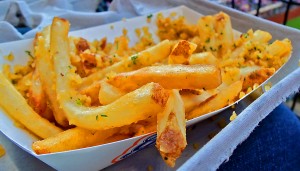 When you mention bread and San Francisco everyone says sourdough. It’s become so associated with San Francisco that no one thinks you can make it anywhere else. You can actually. Sourdough can be made anywhere in the world, but unless it’s made in San Francisco it doesn’t have the correct culture in it that gives it that taste.
When you mention bread and San Francisco everyone says sourdough. It’s become so associated with San Francisco that no one thinks you can make it anywhere else. You can actually. Sourdough can be made anywhere in the world, but unless it’s made in San Francisco it doesn’t have the correct culture in it that gives it that taste.
A funny thing happened to me today. Wife asked me about a certain type of bread that our daughter now loves. She asked me, what makes the crunch on a Dutch Crunch roll? I never had them before I came here. Well that sparked me to search for the history of the Dutch Crunch Roll after looking up what made the crunch [note: it’s a very loose rice flour yeast dough].
As it turns out the bread was originally made in the Netherlands where it is called Tijgerbrood or Tiger Bread. Apparently someone at the Galli Sanitary Bakery made and sold some back in 1909 and called it Dutch Crunch Bread and that was the end of it until around the 60’s or 70’s when the now defunct Parisian Bakery started to make Dutch Crunch Rolls. For some strange reason then never ventured outside of the Bay Area and barely left San Francisco, but having to take the back seat to sourdough bread left a lot of people not having any idea that you could only find it in the Bay Area.
I remember starting to get it around the 80’s so it even took time for the locals to know what it was. I had gone to get a sandwich somewhere and they asked if I wanted it on sourdough or Dutch Crunch. Me being the purist type that I am and thinking that sourdough with anything other than butter is a bit of heresy said, Dutch Crunch. There really isn’t that much special about a Dutch Crunch Roll at first. It’s like white bread in a roll with a crunchy topping and that is really the ultimate simplicity of it that makes it so wonderful for sandwiches.
When you make a sandwich on sliced white bread your fingers compress it into something makes the whole sandwich feel like deli meat wrapped in dough. It’s not a very good sandwich feeling. To this day I can only eat peanut butter and jelly or Bologna and American Cheese on white bread [the more overly processed the better]. If you’re using a sourdough or French roll for a sandwich there are all those big nooks and crannies that everyone likes that really suck if you like mustard or mayo on a sandwich. Enter the Dutch Crunch Roll — it’s white bread — in a roll. It doesn’t turn back to dough when you squeeze it because of the crunchy topping and doesn’t give you pockets to fill with mustard and/or mayo to explode into your mouth or squirt out on your shirt. It is the perfect vehicle for meat and cheese and anything else you put on your sandwich.
I’m sure I could find an architect who could give a dissertation on the construction of the roll extolling the virtues of the hard, crunchy exoskeleton of the roll properly supports the soft, spongy interior that both cradles and grips onto the sandwich ingredients to keep them from fighting their way out of the bread as you eat your sandwich, but I think I’ve done good enough in my last few sentences. While you can make a Dutch Crunch Roll anywhere in the world, for some reason no one’s ever thought of it outside of San Francisco and the Netherlands [though I hear the U.K. is giving it a go now.]









